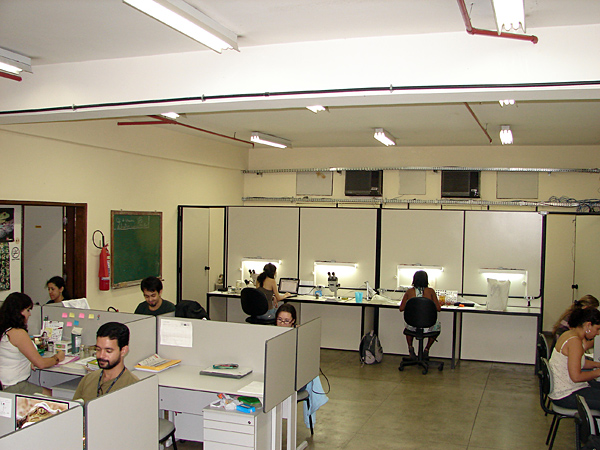Page updated 14/04/2018
Collections of Reptiles and Amphibians
The collections of amphibians and reptiles are continuously enhanced by fieldwork of its researchers and as a depository institution of numerous studies. It also receives material from other sources such as exchanges and donations, through requests made directly to the Curators. Currently the collection of amphibians has about 90,000 specimens and the collection of reptiles about 30,000 specimens. Moreover, as several herpetologists traditionally worked or still work at the National Museum, there is a large number of type specimens (specimens used in the description of the new species to the Science). Due to the importance of its collections, those housed in the Department of Herpetology are continuously studied by Brazilian and overseas researchers through previous contacts with the Curators.
Nowadays the collection of types of amphibians has about 300 nominal species, represented by holotypes, paratypes and syntypes. The Adolpho Lutz collection has about 70 types of nominal species.
The collection of types of reptiles currently has about 65 nominal species, represented by holotypes, paratypes and syntypes. The Adolpho Lutz collection has about 5 types of nominal species.
Instructions for handling fluid-preserved specimens
- The animals must be kept in the same medium in which they were preserved (usually alcohol 70% or formalin 10%).
- Do not use denatured alcohol or another type of alcohol.
- Do not subject the specimens to water.
- Do not let the specimens dry out.
- Keep the specimens away from heat sources.
- Do not expose the specimens to ultraviolet light.
Instructions for handling dry skeletal specimens
- Do not disarticulate the skeleton.
- Do not clean the bones when it is not necessary.
Instructions for handling diaphanized specimens
- The animals must be kept in the same medium in which they were preserved (glycerin 100% with thymol).
- Do not disarticulate the skeleton.
- Do not clean the bones when it is not necessary
» Dissection of Material
» Visit to the colection, Storage and Identification of material
» Tissue collection
Dissection of Material
The study of preserved specimens from scientific collections has increased over the years, associated not only with the increase in the number of researchers and the new techniques of scientific approach, but also with the decrease of new material available. This is due to the collections policies of the bodies in charge and also the decline and extinction of some populations due to loss of natural environment and commercial exploitation. As a result we have: (1) specimens of many species are currently irreplaceable, and (2) the number of researchers that access the material increased and may have conflicting interests regarding the material. Due to these factors we seek to preserve as much of the material in the collection as possible and also all the modifications or dissections in the material must be approved by the Curators in charge. The request must justify the need for change or dissection of the requested material.
Small dissections that are routinely necessary (e.g., sex determination) in taxonomic studies are usually allowed. Requests to do extensive dissection of the specimen (e.g., natural history studies) may be denied by the Curator if the material is rare. Only 1/3 of the total material of the specimen can be authorized to be dissected.
Visitation Policy
All requests to examine specimens deposited in the collections housed in the Department of Herpetology at the National Museum should be made formally through a letter on institutional letterhead. The letter should be addressed to one of the curators expressing the time of the visit (applicants are encouraged to previous contact the curators for scheduling the dates). Request letters may be scanned and sent by e-mail. The requests must be signed by the student advisor or academic supervisor. Any examination of specimens or dissection involving invasive approaches should be explained in detail (see policy of dissections). All orders will be decided case by case, but permission for very destructive approaches is not granted routinely. Any specific demands (eg, ocular millimeter), as well as the observation of type-specimens, should also be included in the request.
How to deposit specimens in the herpetological collections of the National Museum?
The Department of Herpetology at the National Museum regularly receives specimens from scientific studies and consultancies and also has amphibians and reptiles experts in charge of material identification. The material to be deposited in the collection must contain all collection data (under no circumstances will specimens with partial or incomplete data be accepted) and be properly prepared and preserved. Animals in poor condition of preservation (e. g., roadkill animals) will be evaluated by the Curator and may not be accepted by the Institution.
When specimens are sent by post, attention must be paid to the packaging; there should be no risk of leaks or the specimen being crushed (use cloth or gauze moistened with alcohol. Do not use cotton). It is essential that specimens come with all collection data for them to be immediately placed in the collection. Your material will be processed as quickly as possible and the collection number will be sent to you by email.
It is the responsibility of the researcher to obtain the required permission to collect. To get an acceptance letter for the material (for submission to the Bodies in Charge) write directly to one of the Curators.
To cite the collection refer to the section Do you need to identify the specimens?
The deposit of your study material in the Department of Herpetology will allow its free access to researchers and facilitate its use for other studies.
Do you need to identify the specimens?
The herpetological researchers at the National Museum routinely identify specimens of amphibians and reptiles for a third party. This requires the compulsory donation of these specimens to the National Museum. After sending the material (see: How to deposit your specimens in the herpetological collections of the National Museum?), it will be identified in the lowest hierarchical level possible and the corresponding collection number will be sent to the contributor by email, for use in possible future citations in his/her studies.
The acronyms of the collections of amphibians and reptiles are MNRJ (collection of amphibians and reptiles, National Museum, Rio de Janeiro, Brazil). For the Adolpho Lutz collection: AL-MN (collection of amphibians and reptiles, National Museum, Rio de Janeiro, Brazil).
The deposit of your study material in the Sector of Herpetology will allow its free access to researchers and facilitate its use for other studies.
Tissue collection
Unlike traditional specimen collections, tissue samples are eventually depleted with continued use. For this reason, the curators of the Department of Herpetology at the National Museum (MNRJ) established general guidelines for access to the collection in order to ensure that the destructive use does not exhaust this limited resource. These guidelines also apply to the destructive use of traditional specimens (e.g., skeletal material or too invasive studies).
Policy
While developing these guidelines we considered policies instituted by other Natural History Museums. Thus, the main objective here is to preserve the scientific collections for present and future use.
The MNRJ will provide limited tissue samples from their collections to qualified researchers. These samples are intended to complement the material obtained independently (through collection or solicitation to other collections) by users of the collections. Implicit in the term "grant" is the understanding that users will comply with certain requirements (see below). In turn, the MNRJ absorb the high cost of obtaining, cataloging and maintenance of these samples.
The requests for tissue samples or specimens to MNRJ translate the explicit recognition of legitimate scientific collecting, being valued the time and effort required by its researchers in collecting, preparing and maintaining the collections. Upon the granting of such samples for scientific study, we may occasionally ask for a written statement of the importance of the scientific collection and of our collections.
All requests for donation of genetic material must be in written format. Letters must be written on institutional letterhead and addressed to one of the curators. Letters of requests can be scanned and sent by e-mail. Requests of students must also be signed by your academic advisor or supervisor. Requests aliquots of tissue should contain a brief summary of the research that is being developed, including other sources of materials used and a justification explaining why the MNRJ samples are necessary to achieve the aforementioned study.
This letter should specifically address the following items:
- Objectives of the project and its potential scientific value;
- Feasibility and time frame for the conclusion of the study;
- Prior availability of natural or captive populations material, referring to the efforts of the researcher to collect samples;
- Qualification(s) of the person(s) involved in the project to perform the laboratory work;
- Availability of funding to carry out the project in the required time;
- Information about the nature of the required material, including taxon, number of samples, number of genes to be analyzed for each sample, geographical origin and desired method of transport (eg, 95% ethanol).
Analysis of requests
The requests are analyzed case by case according to the following criteria: the type and extent of the request (even if it duplicates efforts carried out previously by other investigators with respect to the MNRJ samples); availability of material based on recent surveys of natural populations; efforts of the researcher in obtaining the material; amount of material in the collections of MNRJ; rarity and difficulty to acquire new samples (e.g., distribution and abundance of the taxon); any Threatened categories in which the species has been included in state and national lists of Endangered Species; if the taxon is included in the CITES list; proven ability by the researcher to undertake the project; financial support for the project.
Granting of samples
Aliquots of tissue or DNA extracts from the herpetological collections of the National Museum cannot be transferred to third parties without the express written permission of one of its curators. The curators will request aliquots of tissue or specimen samples in exchange for the provided MNRJ samples to compensate for the consumed samples. Tissues ceded to MNRJ as compensation must necessarily have testimony specimens deposited in another collection and maintain the numbering of their institution of origin. Tissue samples provided by the MNRJ must remain with the original numbering and cannot be incorporated into other collections. The MNRJ reserves the right to select aliquots of tissue or portion of their previously extracted aliquots, and the method for its preservation (samples in alcohol, frozen or dehydrated), according to request demands and/or easiness of the routine of the collection. At no time requests for aliquots extend to samples deposited in other collections under use by scientific researchers of the MNRJ. These requests should be addressed directly to the curators of the collections of origin of the samples.
The sequences obtained from tissue samples or aliquots of MNRJ should be made available in GenBank at the end of the study, so they are accessible to other researchers. These sequences shall be referred to numbers tumble to the MNRJ, e.g., the catalog number of the respective specimen ("voucher"). The National Museum is to be thanked in all publications that result from the use of their specimens or parts thereof (including aliquots of tissues). These acknowledgments may be addressed directly to the curators of the institution. We request that the PDF of all publications resulting from requests are sent directly to the authorizing curators.
Partial view of the collection

Cabinets of the collection of specimens preserved in liquid medium
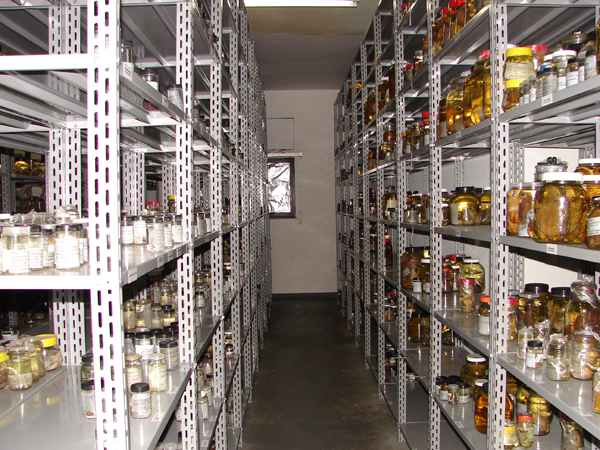
Cabinets of the collection of specimens preserved in liquid medium
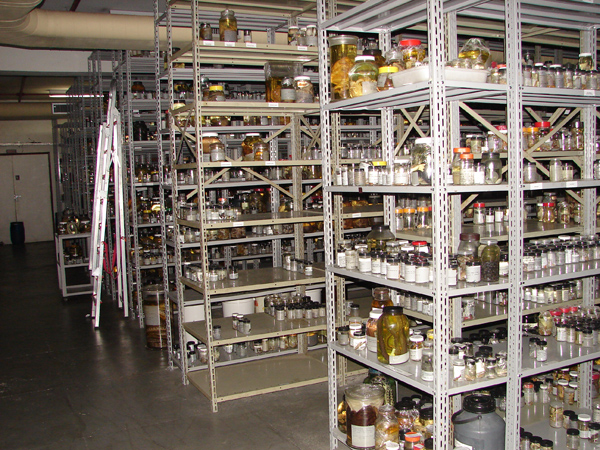
Collection of types
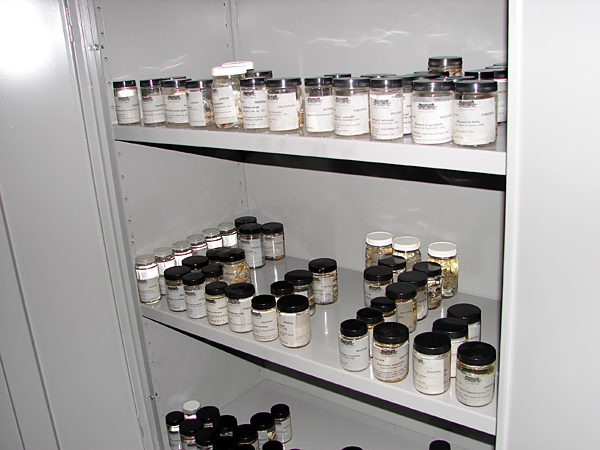
Collection of types
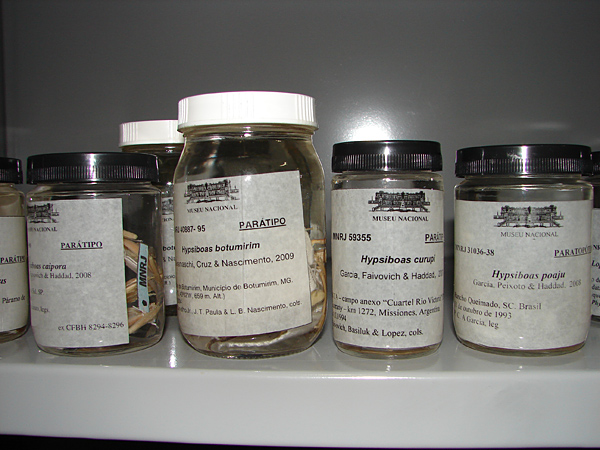
Students’ work room
